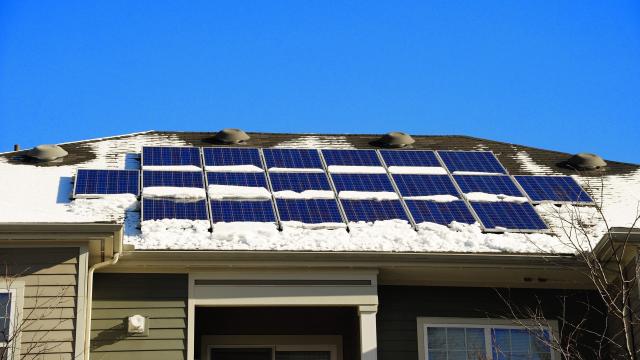Let’s start with the good news: Solar panels can continue to produce energy throughout the winter, even when temperatures really drop. (If you purchased solar panels for your home and live somewhere with cold winters, you probably already know this.) But the less-convenient news is that if your area is also prone to snow and ice, you’ll need to do a bit of maintenance and prep work to keep them functional.
Fortunately, there are a few things you can do now to keep your solar panels operating as smoothly as possible during the colder months. In an article for CNET, Erin Gobler walks us through how to prep solar panels for winter, and maintain them for the rest of the season. Here’s what to know.
Re-angle your panels
Before we go any further, just a quick reminder that prior to actually making any adjustments to your panels, you should run this by your solar panel provider to make sure that it is, in fact, your best option for the winter months. They can also walk you through how to adjust the angles, in case this isn’t something you’ve done before.
Here’s Gobler to explain why adjusting the angle of your solar panels helps:
Because the sun is lower during the winter than in the summer, you’ll want your panels at a steep angle during those months. As an added perk, not only will a steeper angle help to capture more sunlight, but it will also help the snow to more easily fall from your panels.
Check your batteries
Most solar panel batteries weren’t designed to work in frigid temperatures, so Gobler recommends keeping outdoor batteries insulated, or moving them indoors. If you’re opting to keep them insulated outdoors, check in on them from time-to-time to make sure the temperature is in their optimal range. (This is info you can either get from your service provider or the owner’s manual.)
You also need to monitor your batteries’ discharge levels, regardless of whether they’re indoors or outdoors. According to Gobler, allowing your batteries to fully discharge isn’t recommended, and, in fact, “while some batteries may be suited for discharge levels of 70% to 80%, the recommended discharge level is actually 50%.” (This is something else to check in your owner’s manual.)
If there are specific days when you know you’ll be using a lot of energy — like prepping for and/or hosting a holiday gathering — Gobler says you may want to invest in a backup generator (if you haven’t already) and keep it handy, just in case.
Be especially mindful of energy usage
Although we should always pay attention to and try to reduce the amount of energy we use, it’s especially important for those who rely at least partially on solar energy. Cooler temperatures and winter weather aside, we’re all getting less sunlight this time of year, which means getting less energy from our solar panels.
So, as Gobler points out, that leaves you with the option of reducing your energy usage, or being prepared to pay bigger bills over the next few months. If you’re looking for ways to reduce your energy costs, you may want to revisit some of Lifehacker’s previous coverage of this topic.

Leave a Reply
You must be logged in to post a comment.